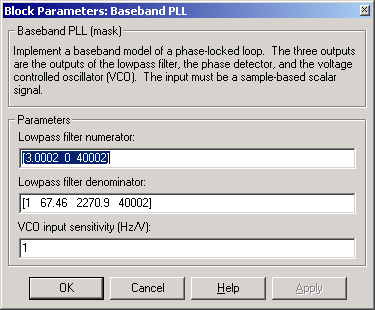| Communications Blockset |
  |
Baseband PLL
Implement a baseband phase-locked loop
Library
Synchronization
Description

The Baseband PLL (phase-locked loop) block is a feedback control system that automatically adjusts the phase of a locally generated signal to match the phase of an input signal. Unlike the Phase-Locked Loop block, this block uses a baseband method and does not depend on a carrier frequency.
This PLL has these three components:
- An integrator used as a phase detector.
- A filter. You specify the filter's transfer function using the Lowpass filter numerator and Lowpass filter denominator mask parameters. Each is a vector that gives the respective polynomial's coefficients in order of descending powers of s.
- To design a filter, you can use functions such as
butter, cheby1, and cheby2 in the Signal Processing Toolbox. The default filter is a Chebyshev type II filter whose transfer function arises from the command below.
[num, den] = cheby2(3,40,100,'s')
- A voltage-controlled oscillator (VCO). You specify the sensitivity of the VCO signal to its input using the VCO input sensitivity parameter. This parameter, measured in Hertz per volt, is a scale factor that determines how much the VCO shifts from its quiescent frequency.
The input signal represents the received signal. The input must be a sample-based scalar signal. The three output ports produce:
- The output of the filter
- The output of the phase detector
- The output of the VCO
This model is nonlinear; for a linearized version, use the Linearized Baseband PLL block.
Dialog Box

- Lowpass filter numerator
- The numerator of the lowpass filter's transfer function, represented as a vector that lists the coefficients in order of descending powers of s.
- Lowpass filter denominator
- The denominator of the lowpass filter's transfer function, represented as a vector that lists the coefficients in order of descending powers of s.
- VCO input sensitivity (Hz/V)
- This value scales the input to the VCO and, consequently, the shift from the VCO's quiescent frequency.
See Also
Linearized Baseband PLL, Phase-Locked Loop
References
For more information about phase-locked loops, see the works listed in Selected Bibliography for Synchronization in Using the Communications Blockset.
 | Barker Code Generator | | BCH Decoder |  |






